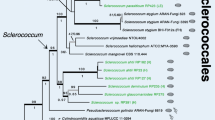Abstract
Chlorangium ahmadii sp. nov. and Circinaria darelensis sp. nov. are described as new species from Pakistan. A comparative morpho-anatomical, chemical study and ITS-based molecular analyses confirmed the positions of these species within the genera Chlorangium and Circinaria. Chlorangium ahmadii sp. nov. differs from its closely related species, C. alpicola in having light brown to whitish-brown thallus (vs. brownish-grey to greyish-green), flat to concave apothecial disc (vs. concave to convex when young, becoming more flat when old), smaller exciple 20–35 μm (vs. 65–85 μm) and larger ascospores 27–40 × 22–25 μm (vs. 19–24 × 19–23 μm). Circinaria darelensis sp. nov. is distinguished from its closely related species, C. maculata in having crustose-areolate light brown to greyish-brown thallus (vs. areolate, brown, olive brown to dark olive), absence of lobes (vs. presence), taller hymenium 120–190 μm (vs. 100–125 µm) and smaller ascospores 14–17 × 6–10 μm (vs. 22.5–27.5 × 15–20 µm).



Similar content being viewed by others
Data availability
The samples used in this study have been deposited at the LAH Herbarium at the University of the Punjab in Lahore. (https://vymaps.com/PK/LAH-Herbarium-Institute-of-Botany-University-of-the-Punjab-Pakistan-334248940395482/). This study’s sequences have been placed in the NCBI Genbank data repository (https://www.ncbi.nlm.nih.gov/genbank/). Mycobank (https://www.mycobank.org/) has received new taxa. (Please check Table 1 for a list of accession numbers and voucher information).
References
Aptroot A, Iqbal SH (2010) Annotated checklist of the lichens of Pakistan, with reports of new records. Herzogia 25:211–229
Din AU, Iqbal MS, Niazi AR, Khalid AN (2023) Two new records of lichens from Pakistan. Biol Bull 50:1195–1200
Gardes M, Bruns TD (1993) ITS primers with enhanced specificity for basidiomycetes-application to the identification of mycorrhizae and rusts. Molec Ecol 2:113–118
Haji-Moniri M, Gromakova AB, Lőkös L, Kondratyuk SY (2017) New members of the Megasporaceae (Pertusariales, lichen forming Ascomycota): Megaspora iranica spec. nova and Oxneriaria gen. nova. Act Bot Hung 59:343–370
Hale, M.E (1979) How to know the lichens, WC Brown Co., Dubuque
Katoh K, Standley DM (2013) MAFFT multiple sequence alignment software version 7: improvements in performance and usability. Molec Bio Evol 30:772–780
Kondratyuk SY, Gromakova AB, Khodosovtsev AY, Kim JA, Kondratiuk AS (2015) Agrestia zerovii (Megasporaceae, Lichen-forming ascomycetes), a new species from South Eastern Europe proved by alternative phylogenetic analysis. Stud Bot Hung 46:69–94
Nordin A, Savić S, Tibell L (2010) Phylogeny and taxonomy of Aspicilia and Megasporaceae. Mycologia 102:1339–1349. https://doi.org/10.3852/09-266
Paukov AG, Davydov EA, Nordin A, Claude ROUX, Şenkardeşler A, Sohrabi M, Vondrák J, Frolov IV, Teptina AY, Shiryaeva AS (2019) Three new species, new combinations and a key to known species of Lobothallia (Megasporaceae). Lichenologist 51:301–322. https://doi.org/10.1017/S0024282919000264
Ren Q, Zhang LH (2018) Taxonomic studies on the genus Circinaria in northern China. Mycosystema 37:865–880
Sambrook J, Russel DW (2001) Rapid isolation of yeast DNA. In: Sambrook J, Russel DW (eds) Molecular cloning: a laboratory manual. Cold Spring Harbor Laboratory Press, New York, pp 631–632
Sohrabi M, Leavitt SD, Halici MG, Shrestha G, Stenroos S (2013) Teuvoa, a new lichen genus in Megasporaceae (Ascomycota: Pertusariales), including Teuvoa junipericola sp. nov. Lichenologist 45:347–360. https://doi.org/10.1017/S0024282913000108
Tamura K, Stecher G, Peterson D, Filipski A, Kumar S (2013) MEGA6: molecular evolutionary genetics analysis version 6.0. Molec Biol Evol 30:2725–2729
White TJ, Bruns T, Lee SJWT, Taylor J (1990) Amplification and direct sequencing of fungal ribosomal RNA genes for phylogenetics. PCR Protoc Guide Methods Appl 18:315–322. https://doi.org/10.1016/B978-0-12-372180-8.50042-1
Zakeri Z, Divakar PK, Otte V (2017) Taxonomy and phylogeny of Aspiciliella, a resurrected genus of Megasporaceae, including the new species A. portosantana. Herzogia 30:166–176
Zulfiqar R, Khalid AN (2023) A novel saxicolous species of Circinaria (Megasporaceae, Ascomycota) from Pakistan. Pl Syst Evol 309:21. https://doi.org/10.1007/s00606-023-01856-0
Acknowledgements
We would like to express our gratitude to Mr. Ali Abbas, Mr. Sheraz Ahmad and Mr. Wahab Kakar for accompanying us on our field trips and helping with the collection.
Funding
The authors declare that they did not receive any funding, grants or other forms of assistance while preparing this paper.
Author information
Authors and Affiliations
Contributions
AUD created the study, designed it, and wrote the initial draft of the manuscript. MSI was in charge of material preparation and data gathering. MSI was in charge of sample collecting and analysis. ANK and ARN provided supervision and final changes to the text. The final manuscript was reviewed and approved by all writers.
Corresponding author
Ethics declarations
Conflict of interest
The authors state that they have no competing interests to report.
Consent for publication
The described work has never been published before.
Additional information
Handling Editor: Miroslav Kolarik.
Publisher's Note
Springer Nature remains neutral with regard to jurisdictional claims in published maps and institutional affiliations.
Rights and permissions
Springer Nature or its licensor (e.g. a society or other partner) holds exclusive rights to this article under a publishing agreement with the author(s) or other rightsholder(s); author self-archiving of the accepted manuscript version of this article is solely governed by the terms of such publishing agreement and applicable law.
About this article
Cite this article
Din, A.U., Iqbal, M.S., Khalid, A.N. et al. Chlorangium ahmadii sp. nov. and Circinaria darelensis sp. nov. two new species of lichenized Ascomycetes from Pakistan. Plant Syst Evol 310, 13 (2024). https://doi.org/10.1007/s00606-024-01893-3
Received:
Accepted:
Published:
DOI: https://doi.org/10.1007/s00606-024-01893-3




